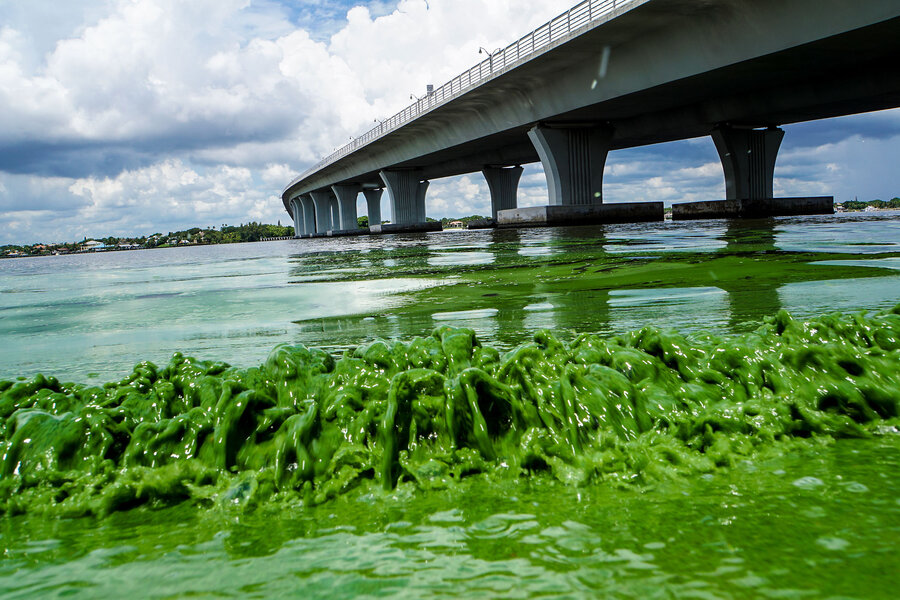How Florida governor plans to fight algae on beaches
Loading...
Florida's Republican Gov. Rick Scott took another stand today against what Florida residents are calling a "guacamole-thick" algae bloom that has inundated a beaches and rivers in Southeastern Florida in recent weeks.
The governor announced that he wants state legislators to direct millions of dollars toward initiatives to address a potential cause of the problem: overflow from septic systems contaminating local waterways. Governor Scott's proposal includes grants for homeowners to switch from septic tanks to central sewer systems. He’s also proposed designating money from the 2017 budget to reconstruction of a wastewater system for residents along the Indian River Lagoon and Caloosahatchee River.
This call to action comes after the governor declared a state of emergency in two of the impacted counties this past week, enabling officials to take “swift action” against the bloom, which is both ecologically harmful and toxic to humans if ingested.
The algae has also been disastrous for the region’s tourism economy.
The smelly green sludge, which coats the surface of slow-moving waterways and coastline, impacted tourism over the Independence Day weekend, when thousands of residents and tourists cancelled travel plans and abandoned the usually crowded beaches, reports ABC News.
"It' a ghost town here in Stuart," Jordan Schwartz with Ohana Surf Shop told local station WFOR. "The discharge has affected our tourism. It's the height of 4th of July weekend and we should be packed in here."
An algae bloom is essentially an overgrown colony of algae caused by an abundance of phosphorus and nitrogen in water. Some algae blooms can be toxic to marine wildlife and ecosystems, cutting off oxygen supply under the water, according to the National Ocean Service. Its spread is also unpredictable, and state officials have set up a hotline and website for residents to report information about the bloom.
The algae invasion appears to be caused by a conflation of several factors – complicating the debate about who should pay for the clean-up and long-term solutions.
The central culprit is pollution in Lake Okeechobee, Florida’s largest freshwater body. Pollution in the lake includes farm run-off, human waste, animal feed and fertilizer, according to CBS News. Contaminates and warming temperatures caused the initial algae bloom that spanned 33 square miles, appearing on the lake in late May.
But Lake Okeechobee is not an isolated body of water, rather it is a central part of the region’s water supply and flood control. Since massive, fatal flooding in 1928, the US Army Corps of Engineers regulated water in the lake, using locks to distribute its water to adjacent waterways, like the St. Lucie River. Release of water from the lake has allowed the algae to move into other waterways, and is potentially responsible for its spread it throughout the region.
In response, officials began holding back 20 billion gallons of water that would have gone into the late and then could have traveled into the St. Lucie River, reports the Treasure Coast Palm.
The role of the lake in the situation has led the governor to call for federal aid, even inviting President Obama to visit.
”The state, as you know, doesn't have any control over Lake Okeechobee," Scott told reporters in West Palm Beach last Tuesday. “The federal government has got to put the money in to be able to hold more water there when we have a rainy year like we have now. It's 100 percent controlled by the federal government."
Yet his call Wednesday for funding for central wastewater systems points to another potential contributing factor. Stormwater runoff and septic tank overflow along other waterways have caused algae bloom in previous years when no water was released from Lake Okeechobee, according to the South Florida Water Management District.
Long-term solutions range from Scott’s suggestion of a new waste water system to completing a planned reservoir. And short term clean-up is difficult: "If you kill this algae, you're going to kill the sea grass, the macro algae, all the good phytoplankton that the fish need, everything else," Bill Louda, a research professor at Florida Atlantic University, told CBS news.
Material from the AP was used in this report.







